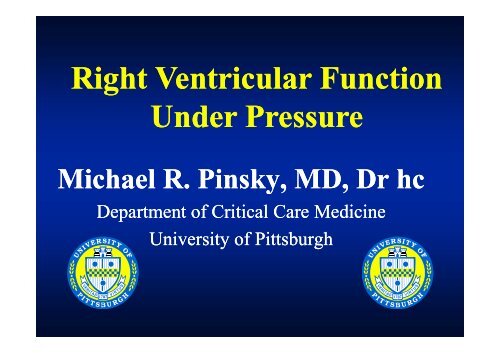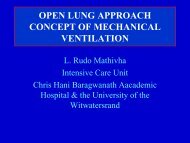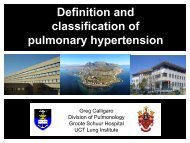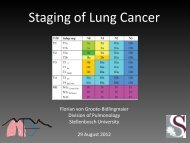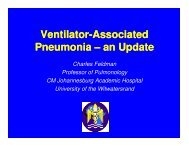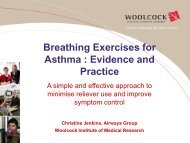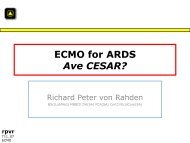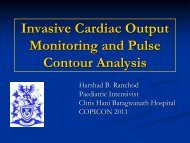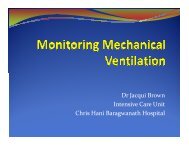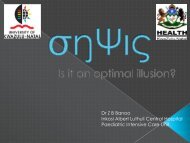Michael Pinsky RV function under pressure
Michael Pinsky RV function under pressure
Michael Pinsky RV function under pressure
Create successful ePaper yourself
Turn your PDF publications into a flip-book with our unique Google optimized e-Paper software.
Right Ventricular Function<br />
Under Pressure<br />
<strong>Michael</strong> R. <strong>Pinsky</strong>, MD, Dr hc<br />
Department of Critical Care Medicine<br />
University of Pittsburgh
Background: Right Ventricle Failure<br />
• Occurs in many disease states<br />
– LV systolic dys<strong>function</strong> and CHF<br />
• Pulmonary disease (cor pulmonale)<br />
– Coronary artery disease (<strong>RV</strong> infarct) • Pulmonary hypertension<br />
– Valvular heart disease (MS, TR, PS)<br />
• Liver disease<br />
– Congenital heart disease<br />
• Worse Prognosis<br />
It is very common<br />
– HF due to systolic dys<strong>function</strong> (de Groote P, et. al. JACC 1998;32:948-54., Ghio S, et. al..<br />
JACC 2001;37:183-8.) 8.)<br />
– Ventricular Assist Device implantation ti (Rose EA, et. Al. NEJM 2001;345:1435-1443.)<br />
1435 1443.)<br />
– Acute myocardial infarction (Sakata, et. al.. Am J Cardiol 2000;85:939-44., Mehta, et. al. JACC<br />
2001;37:37-43.)<br />
– CABG (Eagle It<br />
KA, has et al.. JACC bad 1999;34(4):1262-347.)<br />
outcomes<br />
347.)<br />
– valve surgery (Bonow RO, et. al. JACC 1998;32:1486-588.)<br />
– primary PH (D'Alonzo GE, et. al. Ann Intern Med 1991;115:343–349.) 349.)<br />
– pulmonary arterial embolectomy (Gilbert TB, et. al.. World Journal of Surgery 1998;22:1029-<br />
1033.)<br />
– relative contraindication for liver transplant (Kuo et al. Transplantation 1999;67:1087-1093.) 1093.)
ECG-Gated Gated Multislice Computed<br />
Tomographic Angiography (MSCTA)<br />
to Assess Right Ventricular Function<br />
Simon et al. University of Pittsburgh
Rapid CT 3-D reconstruction of <strong>RV</strong> Cavity by MSCTA<br />
Main pulmonary artery<br />
Pulmonary valve<br />
Superior vena cava<br />
<strong>RV</strong> outflow tract<br />
Tricuspid valve<br />
Right atrium & appendage<br />
Inferior vena cava<br />
Simon et al. University of Pittsburgh
<strong>RV</strong> Systolic Function and Aortic Pressure<br />
<strong>RV</strong> <strong>pressure</strong> 20<br />
Brooks et al. J Clin Invest 50:2176-83, 1971
<strong>RV</strong> Systolic Function and Aortic Pressure<br />
<strong>RV</strong> <strong>pressure</strong> 40<br />
Brooks et al. J Clin Invest 50:2176-83, 1971
<strong>RV</strong> Systolic Function and Aortic Pressure<br />
Brooks et al. J Clin Invest 50:2176-83, 1971
Effects of Right Coronary Blood Flow on Cardiac<br />
Output during Supra-critical PA Pressures<br />
Start of coronary perfusion pump<br />
Brooks et al. J Clin Invest 50:2176-83, 1971
Effects of Pulmonary Hypertension on<br />
Right Coronary Blood Flow<br />
Brooks et al. J Clin Invest 50:2176-83, 1971
LV Pressure-Volume Loop<br />
LV<br />
Pressure<br />
(mm Hg)<br />
End-systole<br />
Ejection (stroke volume)<br />
Isometric<br />
Relaxation<br />
Aortic Valve<br />
Opening<br />
Isometric<br />
Contraction<br />
Mitral<br />
Valve<br />
Opening<br />
Diastolic filling<br />
LV Volume<br />
(mL)<br />
End-diastole<br />
diastole
On the Nature of LV Contraction<br />
Sequential P/V Loops during IVC Occlusion<br />
LV<br />
Pressure<br />
IVC<br />
Occlusion<br />
LV Volume
Right Ventricular Pressure-<br />
Volume Loops<br />
• Conductance Catheter measuring <strong>RV</strong> blood<br />
pool impedance (Leycom,NL)<br />
• High fidelity <strong>pressure</strong> tipped catheter in <strong>RV</strong><br />
(Millar)<br />
• Rapid changes in <strong>RV</strong> volumes or <strong>pressure</strong>s<br />
• Animal model in which measurement<br />
artifacts are minimized (rabbit, piglet)<br />
• Solda et al. J Appl Physiol 73:1770-5, 1992<br />
• <strong>Pinsky</strong> et al. J Crit Care 11: 65-76, 1996
Bi-Ventricular End-Systolic<br />
Pressure Volume Relationships<br />
(generated by IVC occlusion)<br />
Left Ventricle<br />
Right Ventricle<br />
E es<br />
Occlusion<br />
Ees<br />
Occlusion<br />
Diastolic compliance<br />
Diastolic compliance
Assessment of Right Ventricular<br />
Function<br />
<strong>RV</strong> Pressure Assumption:<br />
<strong>RV</strong> end-systolic <strong>pressure</strong>-<br />
volume relation (ESPVR)<br />
correlates with <strong>RV</strong><br />
contractility
Left Ventricular Function<br />
(generated by IVC occlusion)<br />
E es<br />
O l i<br />
m Hg)<br />
ure (mm<br />
V pressu<br />
LV<br />
Ejection<br />
Occlusion<br />
Diastolic compliance<br />
LV volume (ml)
Right Ventricular Function<br />
IVC Occlusion<br />
Hg)<br />
<strong>RV</strong><br />
pressur<br />
re (mm<br />
E es<br />
Diastolic filling<br />
Diastolic compliance<br />
<strong>RV</strong> volume (ml)
Right Ventricular Ejection<br />
Although <strong>RV</strong> Ees can be measured,<br />
does it reflect <strong>RV</strong> contractility tilit<br />
or<br />
the influence of LV ejection<br />
Systolic ventricular<br />
interdependence
Effect of isolated LV contraction on<br />
<strong>RV</strong> Developed Pressure<br />
63.5 LV vs. 36.5% <strong>RV</strong> contribution<br />
to <strong>RV</strong> developed <strong>pressure</strong><br />
Damiano et al. Am J Physiol 261:1514-24, 24, 1991
Effect of isolated LV contraction<br />
on <strong>RV</strong> Developed Pressure<br />
• LV contraction creates 70% of the<br />
developed <strong>RV</strong> systolic <strong>pressure</strong><br />
• Septal contraction not required for this<br />
effect<br />
•The right ventricle is squeezed by the<br />
left ventricular contraction through the<br />
free wall<br />
– Damiano et al. Am J Physiol 261:1514-24, 24, 1991
Effect of Partial Aortic Occlusion<br />
On LV and d<strong>RV</strong>P Pressure-Volume Vl Loops<br />
End-systolic shift<br />
Increased ejection force<br />
<strong>Pinsky</strong> et al. J Crit Care 11: 65-76, 1996
Partial lA Aortic Occlusion<br />
Left ventricle<br />
Closed Pericardium<br />
Right ventricle<br />
E es<br />
End-systolic shift<br />
Shi & <strong>Pinsky</strong> 1994
<strong>RV</strong> elastance in vivo<br />
Cannot Be Defined<br />
• The <strong>RV</strong> ESPVR is directly<br />
dt determined db by the force of fLV<br />
contraction<br />
• Changes in <strong>RV</strong> end-diastolic diastolic volume<br />
and ejection <strong>pressure</strong> may variably<br />
alter contractility
Ventricular Interdependence<br />
• Traditional Concept: Changes in<br />
Right Ventricular volume alters<br />
Left Ventricular <strong>function</strong><br />
• Diastolic interaction Right to Left<br />
–Increased <strong>RV</strong> end-diastolic diastolic volume<br />
decreases LV diastolic compliance<br />
– Decreased <strong>RV</strong> end-diastolic diastolic volume<br />
increases LV diastolic compliance
Increases in <strong>RV</strong> volume decrease<br />
mm Hg)<br />
ssure (m<br />
lar Pres<br />
ntricul<br />
Left Ve<br />
20<br />
LV diastolic compliance<br />
12<br />
<strong>RV</strong> volume:<br />
0 ml<br />
23 ml<br />
2<br />
35 ml<br />
0<br />
47 ml<br />
10<br />
0 10 20 30 40<br />
Left Ventricular Volume (ml)<br />
Taylor et al. Am J Physiol 213:706-10, 10, 1967
Effect of Partial Pulmonary Artery Occlusion<br />
On LV and d<strong>RV</strong>P Pressure-Volume Vl Loops<br />
70 mm Hg<br />
End-diastolic diastolic shift<br />
Decreased compliance<br />
70 mm Hg<br />
LVP<br />
<strong>RV</strong>P<br />
LVV<br />
3.30 ml<br />
<strong>RV</strong>V<br />
<strong>Pinsky</strong> et al. J Crit Care 11: 65-76, 1996
Volume Expansion in Cor Pulmonale<br />
Before Volume Expansion<br />
After Volume Expansion<br />
(500 mL plasma expander)<br />
ΔPP 21% ΔPP 29%<br />
RA<br />
LA<br />
RA<br />
LA<br />
<strong>RV</strong><br />
LV<br />
<strong>RV</strong><br />
LV<br />
CI: 1.3 L/min/m 2<br />
CI: 1.4 L/min/m 2<br />
from Jardin personal communication
Right Ventricular Afterload<br />
Question: Does pulmonary artery <strong>pressure</strong><br />
vary with ih right ventricular outflow<br />
Sometimes,<br />
but at the Extremes of blood flow<br />
(exercise) and in the setting of increased<br />
pulmonary vascular resistance<br />
(pulmonary vascular disease)
Question: Does <strong>RV</strong> Afterload<br />
Change Independent of Pressure<br />
• Afterload is wall stress and varies<br />
with wall tension<br />
– LaPlace’s Law:<br />
Tension = Pressure x radius of<br />
curvature<br />
• Decreasing <strong>RV</strong> radius of curvature<br />
should reduce <strong>RV</strong> afterload<br />
r<br />
P
Mild <strong>RV</strong> Loading Decreases <strong>RV</strong> Wall Stress<br />
<strong>RV</strong> free wall radius decreases!
Representative Images<br />
ECG-Gated Gated Multislice Computed Tomographic Angiography (MSCTA)<br />
to Assess Right Ventricular Function<br />
Normal:<br />
<strong>RV</strong>FAC 0.72<br />
RAP 4 mmHg, MPAP 17 mmHg,<br />
CI 4.9 L/min<br />
PH and <strong>RV</strong> Failure:<br />
Dx: IPF; <strong>RV</strong>FAC 0.18<br />
RAP 18 mmHg, MPAP 50 mmHg,<br />
CI 1.8 L/min<br />
Simon et al. Clin Tranlational Sci 2: 294-9, 9, 2009
Computed Tomography of <strong>RV</strong><br />
Normal<br />
<strong>RV</strong> FAC = 72 %<br />
RA <strong>pressure</strong> 4 mm Hg<br />
mean PA 17 mm Hg<br />
cardiac index 4.9 L/min<br />
End-Diastole<br />
End-Systole<br />
PH/<strong>RV</strong> Failure<br />
<strong>RV</strong> FAC = 18 %<br />
RA <strong>pressure</strong> 10 mm Hg<br />
mean PA 75 mm Hg<br />
cardiac index 1.8 L/min<br />
Simon et al. Clin Translat Sci 2:294-9, 9, 2009
Regional wall stress vs.<br />
Thickness<br />
Infund dibular En nd-Systol lic Wall Stress (kP Pa)<br />
40<br />
30<br />
20<br />
10<br />
0<br />
PH-C<br />
Normal<br />
PH-D<br />
Infundibular End-systolic Wall Thickness (mm)<br />
Normal<br />
PH-C<br />
PH-D<br />
0 2 4 6 8 10 12 14<br />
Simon et al. Clin Translat Sci 2:294-9, 9, 2009
<strong>RV</strong>OT ES Wall Stress vs. Wall Thickness<br />
40<br />
PAH without <strong>RV</strong><br />
Decompensation<br />
P
<strong>RV</strong> Adapts to Increased Pressure<br />
Loads in Response to Increased<br />
Wall Stress<br />
• Hypertrophy is initially heterogeneous<br />
– Outflow track hypertrophies first because<br />
it contracts last and thus sees the highest<br />
wall stress during systole<br />
•<strong>RV</strong> remodeling occurs with pulmonary<br />
hypertension before Pra
Modeling <strong>RV</strong> Wall Strain during<br />
Pulmonary Hypertension<br />
1. Tension in one<br />
principal curvature<br />
T = ⎛ P ⎞<br />
⎛<br />
⎜ ab ⎝ 2 ⎟ a 1+ b2<br />
⎠ a + ⎞<br />
⎜<br />
b2<br />
⎟<br />
⎝<br />
2 c 2<br />
⎠<br />
2A 2. Applied lidto each<br />
T ab<br />
,TT ac<br />
,TT ba<br />
,TT bc<br />
,TT ca<br />
,TT<br />
cb<br />
direction a, b and c<br />
3. Average Orthogonal ⎛<br />
T ab<br />
+ T ac<br />
⎞<br />
T a<br />
= ⎜<br />
⎟ ⎡ ⎛ T<br />
Tension<br />
⎝ 2 ⎠<br />
a<br />
⎞<br />
⎜ ⎟ x 2<br />
⎝ a ⎠ a + ⎛ T ⎞<br />
b<br />
⎜ ⎟ y 2 ⎛<br />
⎢<br />
⎜<br />
⎣<br />
2 ⎝ b ⎠ ⎝<br />
T<br />
4. Average Tension<br />
avg<br />
=<br />
x 2 tA<br />
+ y 2 + z2 at Any Point a 4 b 4 c 4<br />
5. Product of Principal<br />
( T gv ) 2 = T ab<br />
T ac<br />
+ T T 2 ba bc<br />
+ T T 2 ca cb<br />
Tensions a b c<br />
( ) x 2<br />
6. Maximal Tension<br />
at a Point T max<br />
= T avg<br />
+ ( T ac ) 2 − T gv<br />
7. Maximal Stress<br />
( ) y 2<br />
( ) z2<br />
b + T ⎞<br />
c<br />
2 c ⎠<br />
c 2<br />
⎟ z2<br />
c 2<br />
( ) 2 σ max<br />
= T max<br />
max<br />
h<br />
Regen. Ann Biomed Eng 24:400-17, 1996<br />
⎤<br />
⎥<br />
⎦
Modeling <strong>RV</strong> Wall Strain during<br />
Pulmonary Hypertension<br />
Modified 4 Chamber view<br />
Short Axis view
Modeling <strong>RV</strong> Wall Strain during<br />
Pulmonary Hypertension<br />
Str<br />
ress (kPa)<br />
Thickness (mm)
Does <strong>RV</strong> Ejection Efficiency<br />
Vary with Changes in <strong>RV</strong> end-<br />
diastolic volume<br />
Sometimes:<br />
with <strong>RV</strong> overdistention,<br />
ischemia and<br />
pulmonary hypertension
<strong>RV</strong> Adaptation to Pressure<br />
4CH Longitudinal Strain:<br />
Normal patient<br />
0%<br />
-39%
<strong>RV</strong> Adaptation to Mild PAH<br />
4CH Longitudinal Strain:<br />
Pra<br />
Ppa<br />
7 mm Hg<br />
40/16 mm Hg<br />
Mean Ppa 26 mm Hg<br />
Ppao<br />
7 mm Hg<br />
CI 3.73 l/min/m 2<br />
0%<br />
-24%
Severe PAH with Decompensated <strong>RV</strong><br />
4CH Longitudinal Strain<br />
Pra 13 mm Hg<br />
Ppa 111/51 mm Hg<br />
M Ppa 70 mm Hg<br />
Ppao 10 mm Hg<br />
CI<br />
1.3 l/min/m 2<br />
0%<br />
-14%
Echocardiographic Speckle Tracking<br />
Normal<br />
Pulm Hypertension, <strong>RV</strong> Failure<br />
Simon et al. Congestive Heart Failure 15:271-6, 2009
Clinical i l Implications<br />
• Right ventricular diastolic <strong>function</strong> is wedded<br />
to LV filling and cardiac fossal restraint<br />
– Remodelong occurs before Pra increases<br />
–End-diastolic diastolic volume and LV diastolic compliance<br />
– <strong>RV</strong> preload may not vary as <strong>RV</strong> EDV varies<br />
• Right ventricular systolic <strong>function</strong> is wedded<br />
to LV ejection<br />
– Etiology of Backward Circulatory Failure<br />
– Implications for LV Assist Device Use<br />
– Maintain arterial perfusion <strong>pressure</strong> > Ppa
Some Overly Simplistic Rules<br />
to Follow<br />
• Decreasing <strong>RV</strong>ef if not associated with an<br />
increase in stroke volume is bad<br />
• For cardiac output to increase <strong>RV</strong> ESV must<br />
also increase<br />
• The primary treatment for <strong>RV</strong> failure is to<br />
decrease pulmonary artery <strong>pressure</strong><br />
• The primary rescue of <strong>RV</strong> failure is by<br />
increasing arterial <strong>pressure</strong> > Ppa so as to<br />
sustain <strong>RV</strong> coronary perfusion


